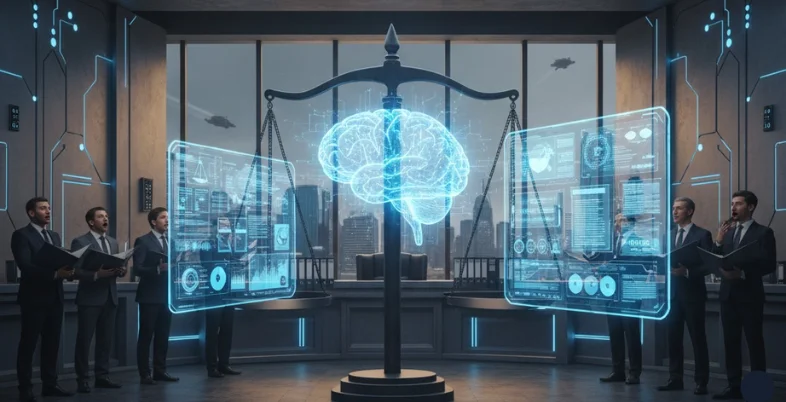Artificial intelligence isn’t just another tech buzzword—it’s fundamentally reshaping how personal injury attorneys research cases, analyze evidence, and predict outcomes. The legal profession has traditionally been slow to adopt new technologies; however, the potential benefits of AI are too significant for law firms to ignore any longer.
From evidence review that used to take weeks down to hours, to predictive analytics that help lawyers estimate settlement values with unprecedented accuracy, AI introduces new efficiency and better client outcomes. However, these advances also create new risks around ethics, accuracy, and the fundamental nature of legal representation.
The transformation is happening now, with early adopters gaining significant competitive advantages while firms that resist change risk being left behind. Understanding both the opportunities and challenges helps legal professionals navigate this technological revolution responsibly while maximizing benefits for their clients.
How AI Streamlines Case Research
Legal research that once required days of manual database searches can now happen in minutes through AI systems that understand complex legal concepts and relationships between cases. These tools don’t just find relevant precedents—they analyze how those cases apply to specific fact patterns and suggest the strongest arguments for particular legal positions.
Document analysis capabilities allow Artificial Intelligence to review contracts, police reports, and discovery materials exponentially faster than human attorneys while identifying patterns and inconsistencies that might be missed during manual review. This speed enables more thorough case preparation without the enormous time costs that previously made comprehensive analysis impractical.
Case law synthesis helps attorneys understand how different precedents interact and which legal theories are most likely to succeed in specific jurisdictions. Artificial Intelligence can analyze thousands of similar cases to identify winning strategies and potential pitfalls that human researchers might overlook.
Citation checking and legal writing assistance reduce errors while improving the quality of legal briefs and motions. AI tools can verify that citations are accurate and current while suggesting stronger arguments based on recent case developments.

AI in Medical Record Review and Evidence Sorting
Medical record analysis transforms from tedious manual work into automated extraction of key injuries, treatment timelines, and cost projections. AI systems can process hundreds of pages of medical documentation within hours and identify the most important information for building damage claims.
Pattern recognition in medical records helps identify treatment gaps, inconsistencies, or evidence of pre-existing conditions that could affect case values. These systems can spot subtle indicators that human reviewers might miss during manual analysis of complex medical histories.
Evidence organization and categorization happens automatically as Artificial Intelligence systems sort through discovery materials, photographs, and witness statements to create organized case files. This automated organization saves countless hours while ensuring that important evidence doesn’t get overlooked in massive document productions.
Quality control features flag potential problems with medical records or evidence that require human review, helping attorneys catch issues before they become problems during settlement negotiations or trials. These alerts help maintain high standards while leveraging AI efficiency.
Predictive Analytics in Settlements and Verdicts
Settlement value predictions based on case facts, injuries, venue, and historical outcomes help attorneys set realistic client expectations while identifying cases that deserve premium compensation. These data-driven estimates provide objective baselines for settlement negotiations.
Jury behavior analysis helps attorneys understand how different types of evidence and arguments perform in specific courts and venues. This insight allows strategic decisions about trial versus settlement based on statistical probabilities rather than gut feelings.
Insurance company behavior patterns emerge through AI analysis of how different insurers handle various claim types, helping attorneys tailor their approaches for maximum effectiveness. Some insurers respond better to aggressive litigation while others prefer collaborative negotiation.
Risk management tools help attorneys evaluate the likelihood of success on different legal theories while identifying potential weaknesses that need to be addressed before trial. This analysis helps optimize case strategies while managing client expectations about possible outcomes.
Ethical and Practical Challenges Ahead
Professional responsibility concerns arise when AI systems make mistakes or generate inaccurate legal advice that attorneys rely on without proper verification. Lawyers remain responsible for all work product regardless of how it’s generated, making human oversight essential.
Client confidentiality requirements demand careful selection of AI tools that meet attorney-client privilege standards and data security requirements. Not all Artificial Intelligence systems provide adequate protection for sensitive legal information, making vendor selection crucial for maintaining ethical obligations.
Bias in AI systems can perpetuate discriminatory patterns in legal outcomes if training data reflects historical prejudices in court decisions or settlement patterns. Attorneys must understand these limitations and work to counteract potential bias in Artificial Intelligence recommendations.
Access to justice issues may worsen if AI advantages become available only to large firms with substantial technology budgets, creating further disparities between well-funded and resource-limited legal representation. The legal profession must address how to democratize Artificial Intelligence benefits.
Conclusion
AI represents a transformative force that will reshape personal injury practice through enhanced efficiency, better case analysis, and improved client outcomes for attorneys who embrace these technological advances. The competitive advantages are already becoming apparent as early adopters demonstrate superior results.
However, successful AI implementation requires careful attention to ethical obligations, quality control, and the human elements of legal representation that technology can’t replace. Attorneys must maintain professional judgment and client relationships while leveraging Artificial Intelligence to enhance their capabilities.
The future belongs to lawyers who understand how to harness AI’s power while preserving the essential human skills of advocacy, judgment, and client counseling. Those who adapt strategically will gain significant advantages while those who resist change risk losing clients to more technologically sophisticated competitors.

